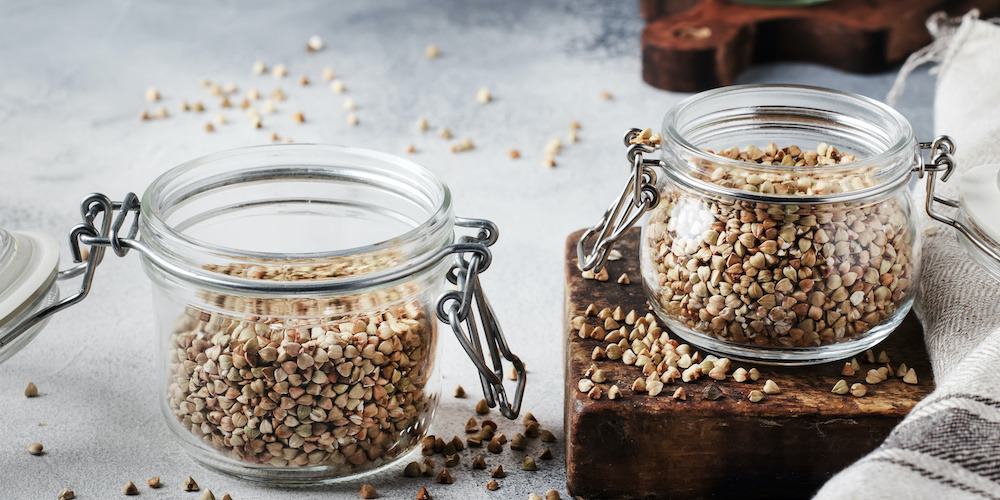BENEFITS OF BUCKWHEAT
✓ Enriches the microbiota
✓ Aids in weight loss
✓ Improves diabetes
✓ Reduces cholesterol levels
✓ Supports cardiovascular health
What is buckwheat?
Buckwheat (Fagopyrum esculentum Moench) is the main representative of the Polygonaceae family. Also called “black wheat”, referring to the color of the husk that surrounds its seeds, it is often associated with cereals.
However, like quinoa, amaranth, or chia, buckwheat is a pseudo-cereal: it is not part of the grasses, but its seeds are consumed as cereals. The genus Fagopyrum includes two main species of buckwheat: Fagopyrum esculentum, or common buckwheat, and Fagopyrum tataricum, Tartary buckwheat.
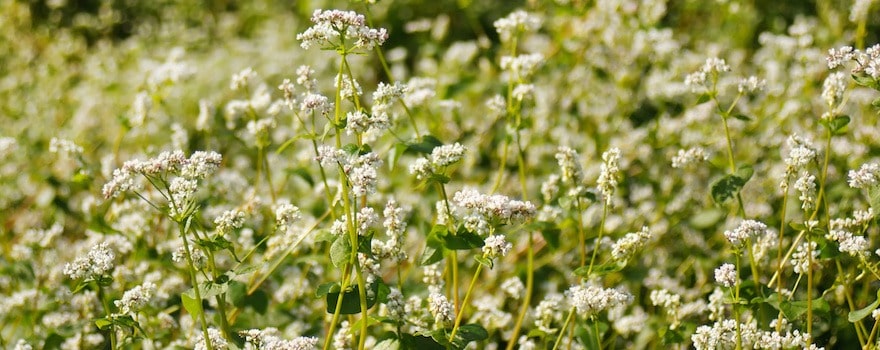
It can reach a height of 70 cm. It has purple stems, heart-shaped leaves, and produces pretty clustered white flowers. Resistant to cold and adapted to poor soils, it has always been appreciated for its ease of cultivation.
Native to Asia, it is first cultivated in Mongolia and China for its seeds intended for human and animal consumption. Though it almost disappeared, it is now making a comeback. It has the advantage of being gluten-free and thus ideal for people with celiac disease or gluten intolerance. It also contains numerous nutrients, including a large amount of protein, fiber, and magnesium.
Buckwheat seeds also have the peculiarity of containing all the essential amino acids for the human body.
This rich and varied composition provides numerous benefits to the body. Buckwheat is particularly interesting as a meat substitute in vegetarian or vegan diets. It also helps with weight loss, improves diabetes, enriches the microbiota, reduces cholesterol, and supports cardiovascular health. Recent studies also show its anti-cancer potential.
Nutritional Composition
- Amino acids including the 8 essentials
- Vitamins: B1, B2, B3, B5, B6, B9, E
- Minerals and trace elements: sodium, potassium, calcium, iron, magnesium, phosphorus, copper, manganese, zinc
- Proteins
- Lipids
- Carbohydrates
- Fiber
- Water
- Polysaccharides: alginate, fucoidan
- Flavonoids: rutin, quercetin, vitexin
- Phenolic acids: caffeic acid, ferulic acid, hydroxybenzoic acid, coumaric acid
- Phytosterols
- Other substances: D-chiro-Inositol, D-Fagomine
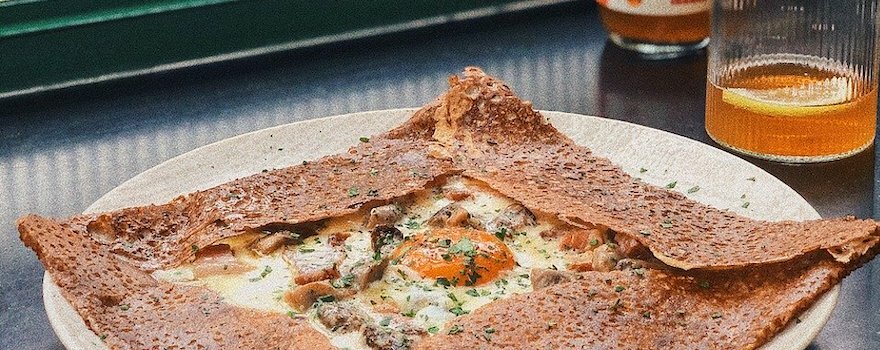
The benefits of buckwheat
♻️ Enriches the microbiota
Like carob, cocoa, or baobab pulp, buckwheat is among prebiotic foods. Thus, it is beneficial for the health of the microbiota (formerly intestinal flora).
On the one hand, its consumption reduces populations of harmful bacteria within the intestine. It notably decreases the presence of enterobacteria, responsible for intestinal disorders and significant diarrhea.
On the other hand, buckwheat promotes the growth of good bacteria like lactobacilli and bifidobacteria. It increases, among others, the populations of Lactobacillus plantarum, Bifidobacterium spp, and Bifidobacterium lactis, essential for microbiota balance.
This study from the University of Madrid (Spain), conducted on rats, shows the beneficial effects of buckwheat as a prebiotic food.
🏃🏻♂️ Aids in weight loss
Buckwheat is a valuable ally for losing weight. Thanks to its high fiber content, it promotes a feeling of fullness and limits snacking throughout the day.
100 g of buckwheat seeds contain about 10 g of dietary fiber, which is more than some grains like barley or oats. These are mainly soluble fibers, such as pectin, which have the unique ability to transform into a viscous gel when in contact with water. Once in the stomach, these fibers swell and accelerate the feeling of fullness, reducing the urge to snack.
Furthermore, they slow down the absorption of lipids and carbohydrates into the blood to limit the storage of fats in the body. In this respect, it acts like other superfoods such as psyllium, chia seeds, or guar gum.
The fibers in buckwheat also have the advantage of being very digestible and suitable for sluggish digestion. They facilitate digestion and the passage of food through the intestinal tract, important factors for healthy weight loss and a flat stomach.
This study from the University of Ljubljana (Slovenia), conducted on healthy individuals, shows how buckwheat accelerates satiety.
🍭 Improves Diabetes
Buckwheat fiber also has a beneficial effect on type 2 diabetes. They notably help to normalize blood glucose levels and prevent insulin spikes after meals.
In addition to fiber, the seeds contain a fairly rare natural compound in food: D-chiro-Inositol (DCI). It is an insulin mediator that reduces insulin resistance. It also maintains blood sugar levels and speeds up glucose elimination.
Buckwheat also contains D-fagomine, a sugar that reduces fat accumulation and alleviates insulin resistance. It also helps to delay the onset of a pre-diabetic state during a diet too rich in fats.
Finally, it has the advantage of having a low glycemic index equal to 40, which is lower than that of wheat, rice, or rye.
This study from the University of Manitoba (Canada), conducted on rats, shows the effectiveness of D-chiro-Inositol in lowering blood sugar levels.
This other study from the Institute for Food and Nutrition Development of China, conducted on patients with type 2 diabetes, shows how buckwheat alleviates insulin resistance and improves lipid profiles.
🍳 Reduces Cholesterol Levels
Because it contains a large amount of fiber, buckwheat fights against hyperlipidemia, which manifests as high cholesterol levels. Its fiber limits cholesterol absorption and promotes its elimination when in excess.
It increases the level of HDL-cholesterol (or “good cholesterol”) and decreases the level of LDL-cholesterol (or “bad cholesterol”). The cholesterol-lowering action of the fibers is complemented by certain amino acids found in buckwheat such as arginine and carnitine.
Finally, it contains vitamin B3 (or niacin), which reduces cholesterol concentration in the blood.
This study from Uppsala University (Sweden), conducted on women, explains how buckwheat lowers cholesterol levels.
❤️ Supports Cardiovascular Health
By lowering cholesterol levels, buckwheat contributes to cardiovascular health and limits the risk of heart diseases. It also contains various nutrients beneficial for the heart.
Its flavonoids, like quercetin, are protectors of blood vessels. They strengthen and improve the elasticity of arteries. Like ginkgo biloba, buckwheat is also an excellent source of rutin which protects against clot formation.
Finally, magnesium, copper, and vitamin B6 maintain good cardiovascular health and prevent certain disorders like heart palpitations.
This study from Hebei United University (China), conducted on rats, shows how buckwheat rutin inhibits cardiomyocyte hypertrophy associated with heart failure.
🔬 Potentially Anti-Cancer
Various studies have shown the anti-cancer potential of buckwheat, notably against breast and colon cancer. Its action is largely attributed to the fibers and proteins it contains.
On one hand, it exerts anti-proliferative effects: it limits the development of cancer cells, prevents their migration and invasion within the body.
On the other hand, it induces apoptosis, that is, programmed cell death. Cancer cells then trigger their self-destruction.
This study from Jiangnan University (China), conducted on a cancer cell line, shows the different anti-cancer actions of buckwheat.
This other study from Kangwon National University (South Korea), also conducted on cancer cells, shows how buckwheat inhibits their development.
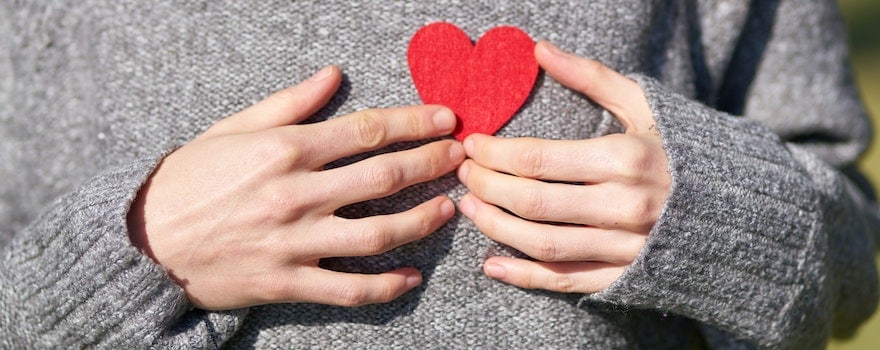
How to consume buckwheat?
Buckwheat seeds
Buckwheat seeds, whole or hulled (called “white buckwheat”), have a pronounced nutty taste. Versatile, they are ideal as a side dish for salads, meat, vegetables, and fish dishes. They can advantageously replace rice, pasta and can be consumed in many ways.
For example, buckwheat seeds can be cooked risotto-style, integrated into vegetarian preparations (meatballs, falafels, pancakes…), or simply sautéed.
They can also be incorporated into sweet recipes: cookies, pies, crumbles, porridges…
The seeds tend to soften and soak up water when cooked for too long. It is important to rinse them and cook them over low heat in twice their volume of water for about 15 minutes. Then, let them sit off the heat for 5 to 8 minutes. This results in firm and crunchy buckwheat.
Toasted buckwheat seeds
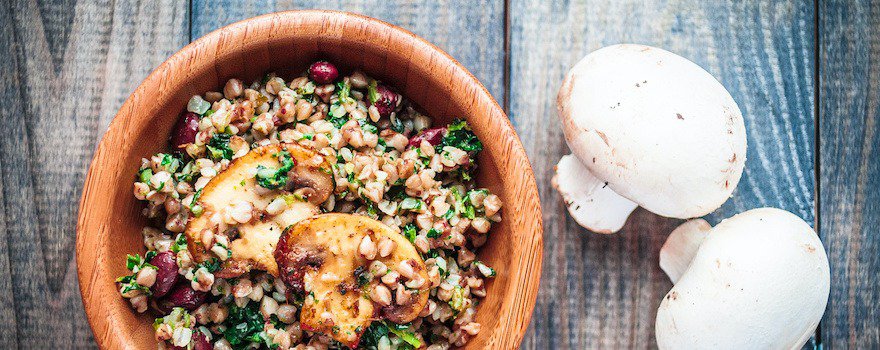
Hulled and toasted buckwheat seeds are called “kasha”. It is an Eastern European specialty with a roasted nut flavor, often consumed as groats, soup, stew, and porridge. Kasha offers a distinct and stronger taste than original buckwheat.
It can be purchased or easily prepared at home. Simply toast the hulled buckwheat seeds in a pan, without fat, until they turn golden brown.
Kasha is tender enough to be eaten raw. You can eat it as is or add it to your muesli and cereal mixes. It can also be cooked in 1.5 times its volume of water and in just 5 minutes.
Finally, kasha allows for the preparation of a delicious Japanese infusion called “Sobacha.” The seeds are infused for 5 minutes in boiling water. Use 4 g of seeds for a 20 cl cup. You can enhance your Sobacha with green tea leaves, honey, or lucuma powder.
Buckwheat flakes
Buckwheat flakes are obtained by crushing the seeds and then undergoing gentle steam cooking. Perfect for breakfast, they can also be added to creams, soups, pancakes, biscuits, yogurts, purées…
Added before the end of cooking, the flakes can be used to thicken homemade soups and veloutés.
Buckwheat flour
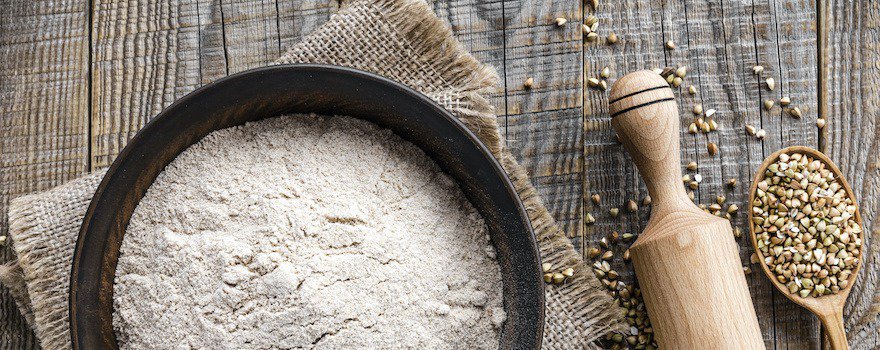
Because it has a quite bitter taste, buckwheat flour is often used in combination with other flours (except for Breton pancakes). If you want to retain its “gluten-free” advantage, opt for rice, quinoa, corn, chestnut flours… which are also gluten-free. Buckwheat flour accounts for 20 to 25% in the mixture.
Buckwheat flour allows for the making of bread, cakes, pancakes, crepes… It is also included in the recipe for famous Japanese Soba noodles.
Sprouted buckwheat seeds
It is possible to buy or sprout hulled buckwheat seeds yourself. Sprouting is simple and quick (around 2 to 3 days). The seeds have then a very mild and neutral taste. Once rinsed, they can be consumed raw or steamed, enhance a salad, a smoothie or be accompanied by other sprouted seeds.
Sustainable consumption: favor local, organic, and fair-trade buckwheat
✓ Even though China, Russia, Ukraine, and Kazakhstan are currently the main producing countries, buckwheat has long been cultivated in France. Introduced in the 20th century, its cultivation represented around 300,000 hectares, with a large part located in Brittany. Unfortunately, like millet or spelt, buckwheat has gradually disappeared from our regions, replaced by rice and cereals.
✓ Today, farmers are attempting to rehabilitate buckwheat cultivation in Brittany. By purchasing French origin buckwheat, you contribute to the development of this local crop. Also, prioritize products from organic farming.
✓ There are also fair trade networks for buckwheat (including in France) that support family farming.
Dosage
There is no really recommended dosage for buckwheat. It can replace the portion of starchy foods advised to be consumed daily.
- Buckwheat seeds: 50 g per person
- Buckwheat flakes: 100 to 200 g per day
- Buckwheat flour: 20 to 25% of the preparation
- Sprouted buckwheat seeds: 1 to 2 teaspoons per person, 2 to 3 times a day
Contraindications and Side Effects
The consumption of buckwheat presents certain contraindications:
- Due to possible cross-allergy, people allergic to latex or rice should avoid consuming it
- People with gastrointestinal disorders, irritable bowel syndrome, or Crohn’s disease should consume it in moderation.
The consumption of buckwheat presents few undesirable effects. In case of excessive consumption, the following side effects may appear:
- Allergic reaction
- Flatulence
- Intestinal cramps
If you experience side effects, stop your consumption and consult a doctor.
History, Culture, and Market of Buckwheat
The oldest traces of agricultural cultivation of buckwheat date back to the mid-6th millennium in northern China. It then spread to southern Himalayas, the Caucasus, and Europe during the 14th century.
Black wheat is notable not only for the nutritional richness and health benefits of its seeds. Buckwheat is also interesting for biodiversity and the development of more environmentally-friendly agriculture.
On one hand, buckwheat flowers are very melliferous. They attract numerous pollinating insects (bees, butterflies, bumblebees…) that feed on the nectar in July-August. The bees then produce buckwheat honey. Rare and sought after, it offers pronounced aromas and a beautiful dark color.
In agriculture, it also has many uses. It’s an excellent green manure that, in addition to smothering weeds, enriches the soil and improves soil structure. Furthermore, buckwheat is not demanding in fertilizers and generally has no pests or diseases. Its cultivation, therefore, allows for reduced use of chemicals (fertilizers, pesticides, herbicides…). Another reason to revive this long-forgotten plant.
Dossier prepared by Julia Perez
Sources and scientific studies
V Skrabanja, H G Liljeberg Elmståhl, I Kreft, I M Björck, 2001. Nutritional properties of starch in buckwheat products: studies in vitro and in vivo.
Julianne M Kawa, Carla G Taylor, Roman Przybylski, 2003. Buckwheat concentrate reduces serum glucose in streptozotocin-diabetic rats.
Ju Qiu, Yanping Liu, Yanfen Yue, Yuchang Qin, Zaigui Li, 2016. Dietary tartary buckwheat intake attenuates insulin resistance and improves lipid profiles in patients with type 2 diabetes: a randomized controlled trial.
G.Préstamoa, A.Pedrazuelab, E.Peñasa, M.A.Lasunciónc, G.Arroyob, 2003. Role of buckwheat diet on rats as prebiotic and healthy food.
Gunilla Wieslander, Nina Fabjan, Maja Vogrincic, Ivan Kreft, Christer Janson, Ulrike Spetz-Nyström, Blanka Vombergar, Christer Tagesson, Per Leanderson, Dan Norbäck, 2011. Eating buckwheat cookies is associated with the reduction in serum levels of myeloperoxidase and cholesterol: a double blind crossover study in day-care centre staffs.
Jin-xiu Chu, Guang-min Li, Xiu-juan Gao, Jian-xing Wang, and Shu-ying Hana, 2014. Buckwheat Rutin Inhibits AngII-induced Cardiomyocyte Hypertrophy via Blockade of CaN-dependent Signal Pathway.
Xiaona Guo, Kexue Zhu, Hui Zhang, and Huiyuan Yao, 2010. Anti-Tumor Activity of a Novel Protein Obtained from Tartary Buckwheat.
Soo-Hyun Kim, Cheng-Bi Cui, Il-Jun Kang, Sun Young Kim, Seung-Shi Ham, 2007. Cytotoxic effect of buckwheat (Fagopyrum esculentum Moench) hull against cancer cells.
Harriet V. Hunt, Xue Shang, corresponding, Martin K. Jones, 2018. Buckwheat: a crop from outside the major Chinese domestication centres? A review of the archaeobotanical, palynological and genetic evidence.


